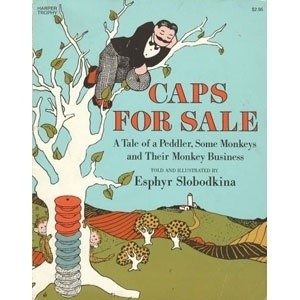by JoAnn Conrad, Recipient of the 2015 Billie M. Levy Travel and Research Grant
Part of my ongoing research into children’s picturebooks of the mid-twentieth century has to do with the ways in which the work of illustrators has insinuated itself into the public memory even as the names of individual artists may be relatively obscure. This is the case with the rare female artist and, particularly, Esphyr Slobodkina, as her influence is inversely proportional to the obscurity of her name. “Esphyr Slobodkina . . .helped pave the way for the acceptance of abstract art in the United States and translate[d] European modernism into an American idiom.”[1]
A simple and serendipitous anecdote demonstrates this: While researching her papers at UConn’s Archives and Special Collections this summer, I was living across the street from the UConn Bookstore. One day, I noticed a display in the window announcing “Caps for Sale” [Fig. 1], clearly alluding to one of Slobodkina’s most popular books of the same name [Fig. 2]. The power of the sale poster derives from and depends on the reference to the book, which is assumed to be automatic.
There is a fair amount about Slobodkina’s life and work available. The Finding Aid for the Slobodkina Papers at Archives and Special Collections provides a brief biography as does the website of the Esphyr Slobodkina Foundation. The 2009 Rediscovering Slobodkina: A Pioneer of American Abstraction includes information on her life as well as her contributions to the art world, but the full biography has yet to be written. Esphyr Slobodkina anticipated that it would be written, however, and drafted a comprehensive, detailed, 5-volume manuscript “Notes for a Biographer” which resides in her papers. The Slobodkina Papers contain much more than is in her books – things that would never be published but which give a researcher like me access to insights into the thoughts and motivations of the artist. One of the pleasures of this kind of archival research is not only this intimate and personal connection one makes across time, but also the unexpected revelations into the personality of the artist that informs her work. My intention here is to provide some of those “off the books” glimpses into the work and person – Esphyr Slobodkina.
Esphyr Slobodkina was born to a wealthy Russian-Jewish family in Russia before the Revolution. Continue reading…


